U. S. Geological Survey Open-File
Report 01-041
A Laboratory Manual for X-Ray Powder
Diffraction
ORIENTED AGGREGATE MOUNTS FOR X-RAY POWDER DIFFRACTION
The clay fraction can be separated from the bulk sample by centrifugation or decantation and mounted as an oriented aggregate mount for clay-mineral identification. The oriented aggregate mounts force the clay mineral particles , usually plate-shaped phyllosilicates, to lie flat, allowing the operator to direct the incident X-ray beam down the z axis of the minerals and to record the diagnostic basal diffractions. It is the z axis that shows the extent of d-spacing expansion and (or) contraction indicative of certain clay minerals during subsequent treatments. These treatments include: air drying, glycolation with ethylene glycol, heating to 400 C, and heating to 550 C. The material from the randomly oriented powder mount may be used for this analysis.
Commonly used substrates for oriented aggregate mounts include silver filters, ceramic tiles, and glass slides. Silver filters tend to be expensive and react with chloride ions to form crystalline compounds that change the mass-absorption coefficient of the mount and affect peak intensities (Poppe and others, 1989); ceramic tiles tend to contain crystalline material that may complicate the diffraction pattern. Glass slides cut to fit the sample holder of a diffractometer are used in the filter-peel method (Drevers, 1973; Pollastro, 1982) described below.
| PREPARATION OF ORIENTED AGGREGATE MOUNTS USING THE FILTER-PEEL TECHNIQUE |
Materials Required:
- glass slides cut to fit diffractometer
- carbide or diamond glass scriber
- lab tissues
- vacuum pump
- Millipore filtration apparatus vacuum tubing
- Millipore HA, 47-mm, 0.45-micron
nominal pore opening cellulose filters
- pipette or 20-25 cc syringe
- single-edge razor or metal spatula
- cylinder with a 2.5 - 5 cm outside diameter
|
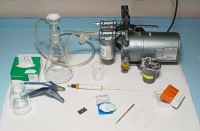 |
| Cut the glass slides to fit the sample holder and label them with a scriber. Rinse and dry the slides to remove any remaining glass shards. |
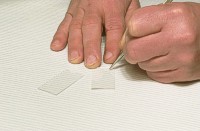 |
| Assemble the filtration device with the cellulose filter in place. Pour approximately 20 ml of the clay suspension into the assembled filtration device. Exact amount will depend on the density of the suspension, mineralogy, presence of organics, and grain size of the particles. |
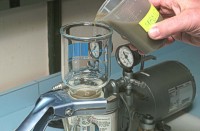 |
| If the filter clogs, use the pipette or a syringe with a needle attached to remove the excess clay suspension from the filtration device. |
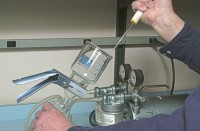 |
| As soon as the remaining suspension has been completely drawn into the filter, remove the glass funnel and use a single-edge razor or metal spatula to remove the moist filter from the filtering device. |
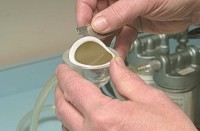 |
| Wrap the filter membrane tightly around the cylinder with the clay film up and held firmly with the thumb and forefinger. |
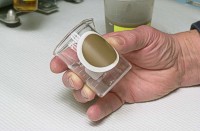 |
| Membrane filter and clay film are center-positioned near the glass slide and then quickly and smoothly lightly rolled across the slide to transfer the clay film to the slide. Any hesitation or jerky motion during the transfer may cause rippling of the film and disrupt the preferred orientation. |
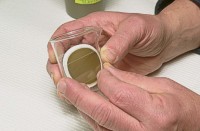 |
| The mounts dry in a few minutes and are then ready for X-ray diffraction analysis. The specimens are subsequently exposed to glycol or heat treatments. |
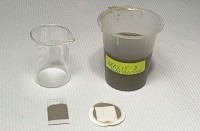 |
